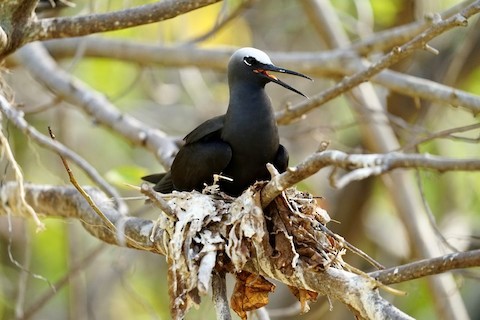Birdfinding.info ⇒ The Pacific form of Black Noddy is locally common on and around its nesting islands, throughout much of Micronesia, Melanesia, and Polynesia. It can be found around many popular resort destinations of the South Pacific, including those of Tahiti and Fiji. Some of its more accessible breeding colonies are on islands of Queensland’s Great Barrier Reef, including Michaelmas Cay, Heron Island, and Lady Elliot Island. Lone individuals or small groups often appear at various sites along the eastern coast of Australia from the vicinity of Cairns south to Sydney. Its status in the main Hawaiian islands is unclear due to the difficulty of distinguishing it from immature “Hawaiian Noddy”, but it has been confirmed nesting on Lehua Islet (beside Ni’ihau) and there are records of apparent “Pacific Blacks” photographed in “Hawaiian” colonies, such as the one at Wai’anapanapa State Park on Maui.
“Pacific Black Noddy”
Anous minutus minutus
Tropical Pacific and adjacent seas. Mainly pelagic and rarely seen from land except on its island breeding grounds, where it nests mainly in trees.
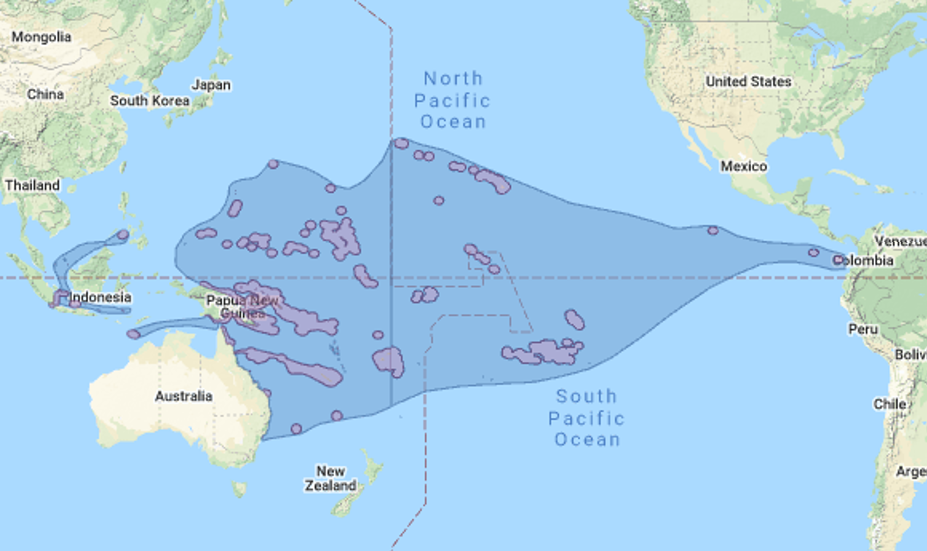
Approximate distribution of “Pacific Black” and “Hawaiian Noddies” combined. © Xeno-Canto 2020
Breeds colonially on islands that span most of the tropical Pacific. Traditionally divided into four subspecies, although the distinctions are not readily apparent.
In the North Pacific: marcusi breeds in Micronesia and adjacent archipelagos from the Marianas, and Marcus Island east to Johnston Atoll and the Northwest Chain of Hawaii, and south to Palau, the Malukus, the Bismarck Sea, and the Marshall Islands; worcesteri breeds in the Philippines on Cavilli and Tubbataha Reef; and diamesus breeds in the far eastern Pacific on Clipperton (Mexico) and Cocos (Costa Rica) Islands.
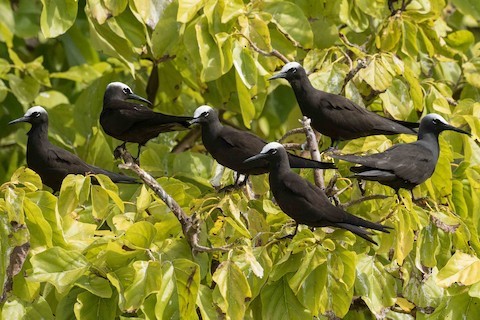
“Pacific Black Noddy,” A. m. minutus, exhibiting its arboreal habits. (Motu Tapu, Kiribati; August 18, 2019.) © Eric VanderWerf
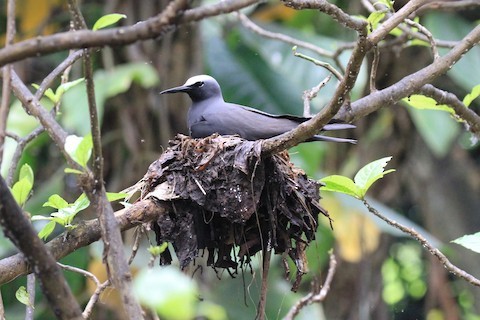
“Pacific Black Noddy,” A. m. marcusi, nests mainly, if not exclusively, in trees and bushes. (Tench Island, New Ireland, Papua New Guinea; July 10, 2016.) © Charles Davies
In the South Pacific: minutus breeds on islets from the Timor Sea (west to Adele Island and Ashmore Reef in the northeastern Indian Ocean) east across the Coral Sea, Melanesia, and western and central Polynesia to the Tuamotu Archipelago and Marquesas, south to Lord Howe and Norfolk Islands.
Small numbers of nonbreeders appear regularly at various points along the eastern coast of Australia.
Identification
Like other members of the Black Noddy “complex,” mostly black or blackish-brown with a white crown and long, thin bill.
Adults in fresh plumage appear almost entirely black or blackish—often detectably browner on the back and wing coverts. Their plumage turns browner with wear, and when heavily worn, it can appear almost entirely brown, or sometimes grayish on the head and neck.
The legs and feet are usually black, but can sometimes be paler shades, sometimes reddish, sometimes orangish.

“Pacific Black Noddy,” A. m. marcusi. (French Frigate Shoals, Hawaii; October 20, 2006.) © Cory Gregory
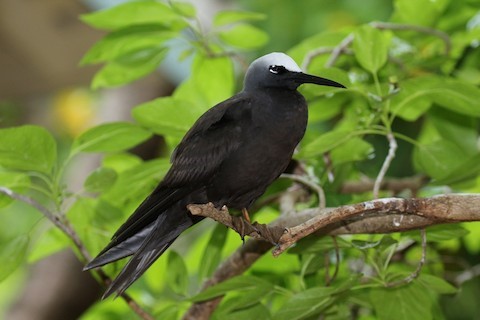
“Pacific Black Noddy,” A. m. minutus. (Heron Island, Queensland, Australia; February 22, 2016.) © Jon Pleizier
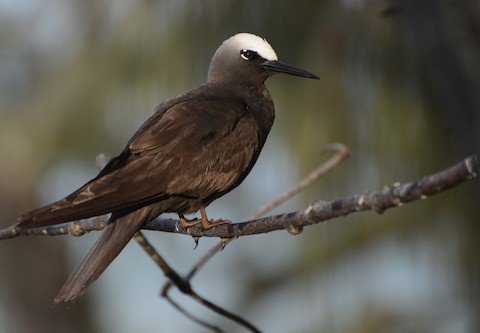
“Pacific Black Noddy,” A. m. minutus. (Heron Island, Queensland, Australia; March 21, 2018.) © Bridget Spencer
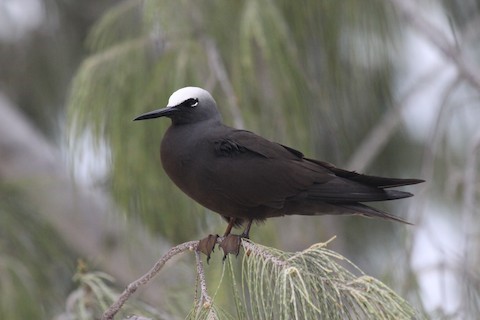
“Pacific Black Noddy,” A. m. minutus. (Heron Island, Queensland, Australia; January 8, 2010.) © Richard Fuller

“Pacific Black Noddy,” A. m. marcusi. (Sand Island, Midway Atoll National Wildlife Refuge, Hawaii; October 11, 2020.) © Atlee Hargis
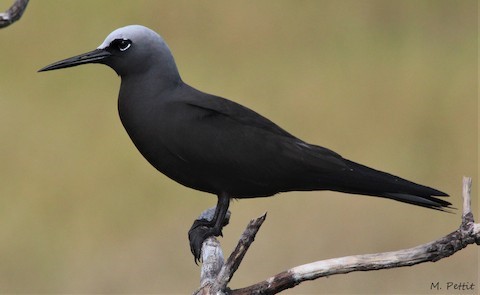
“Pacific Black Noddy,” A. m. minutus. (West Island, Ashmore Reef, Western Australia; April 29, 2019.) © Magen Pettit

“Pacific Black Noddy,” A. m. minutus, on nest. (Lady Elliot Island, Queensland, Australia; October 12, 2014.) © Matt Hinze
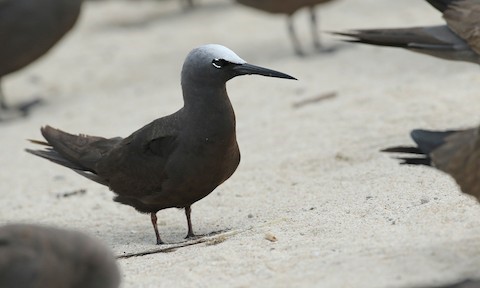
“Pacific Black Noddy,” A. m. minutus. (Michaelmas Cay, Queensland, Australia; March 1, 2016.) © Luke Seitz

“Pacific Black Noddy,” A. m. minutus. (Heron Island, Queensland, Australia; December 12, 2020.) © Frank Coman
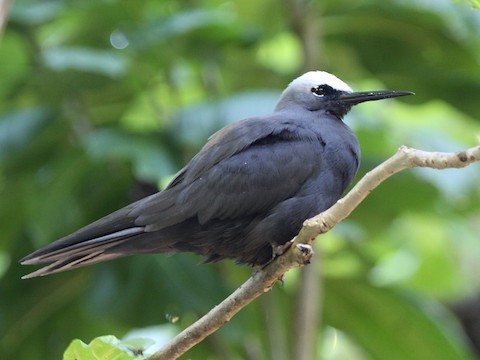
“Pacific Black Noddy,” A. m. minutus. (Heron Island, Queensland, Australia; July 30, 2012.) © Pavel Parkhaev
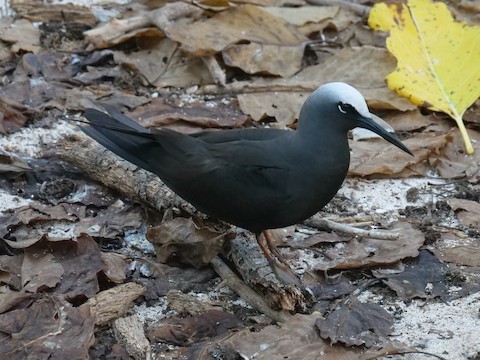
“Pacific Black Noddy,” A. m. minutus, with brownish legs. (Heron Island, Queensland, Australia; December 2, 2020.) © Frank Coman
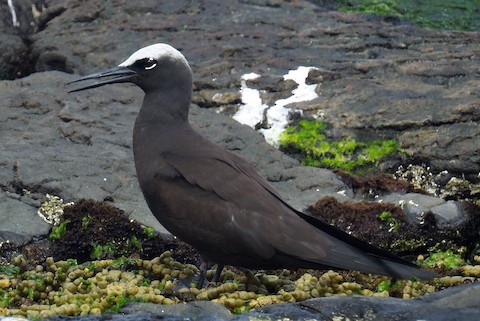
“Pacific Black Noddy,” A. m. minutus. (Flat Rock, Ballina, New South Wales, Australia; March 4, 2018.) © Steven McBride

“Pacific Black Noddy,” A. m. minutus. (Heron Island, Queensland, Australia; December 6, 2020.) © Frank Coman

“Pacific Black Noddy,” A. m. minutus. (Tench Island, New Ireland, Papua New Guinea; July 13, 2014.) © Lars Petersson
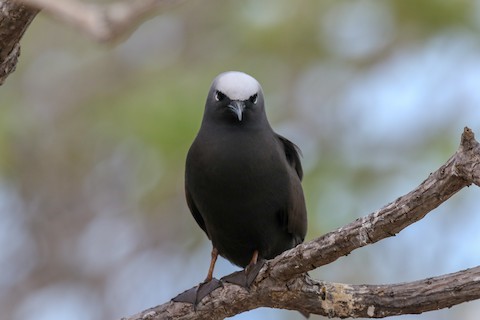
“Pacific Black Noddy,” A. m. minutus. (Motu Tapu, Kiribati; February 22, 2019.) © George Henry Stirrett
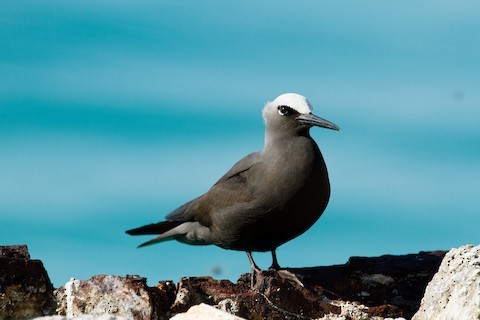
“Pacific Black Noddy,” A. m. marcusi. (Sand Island, Midway Atoll National Wildlife Refuge, Hawaii; April 18, 2011.) © Garrett Lau
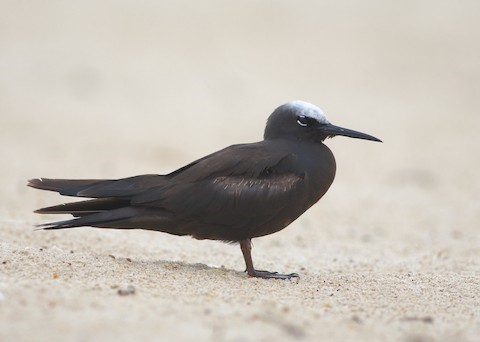
“Pacific Black Noddy,” A. m. minutus. (Cathie Creek Estuary, Lake Cathie, New South Wales, Australia; January 11, 2018.) © Liam Murphy

“Pacific Black Noddy,” A. m. minutus. (Lady Elliot Island, Queensland, Australia; February 4, 2016.) © Ray Turnbull
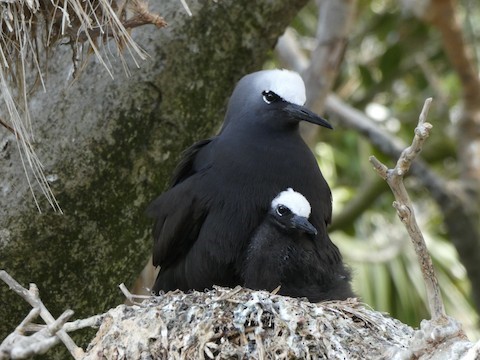
“Pacific Black Noddy,” A. m. minutus, adult with nestling. (Lord Howe Island, Australia; November 19, 2018.) © Allison Turner

“Pacific Black Noddy,” A. m. minutus. (Flat Rock, Ballina, New South Wales, Australia; December 2, 2018.) © Steven McBride

“Pacific Black Noddy,” A. m. minutus. (Heron Island, Queensland, Australia; April 22, 2019.) © Martin Allen
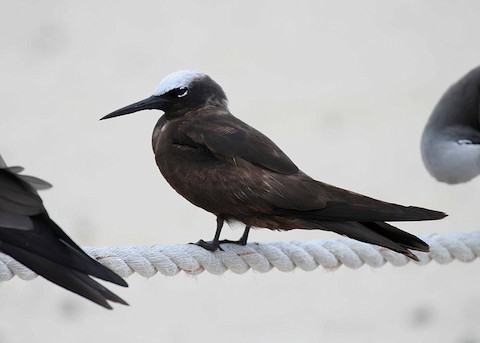
“Pacific Black Noddy,” A. m. minutus. (Michaelmas Cay, Queensland, Australia; December 3, 2007.) © Megan Perkins
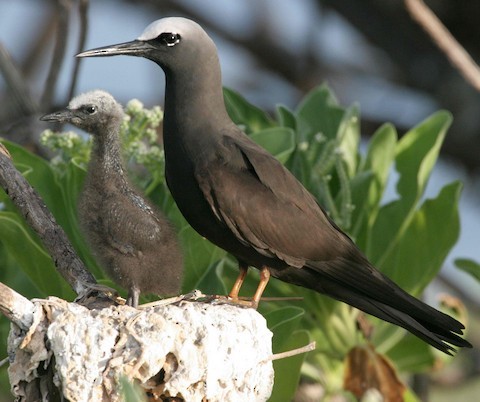
“Pacific Black Noddy,” A. m. minutus, adult with nestling—note adult’s unusually orangish legs, like “Hawaiian Noddy”. (Christmas Island, Kiribati; June 18, 2007.) © Eric VanderWerf
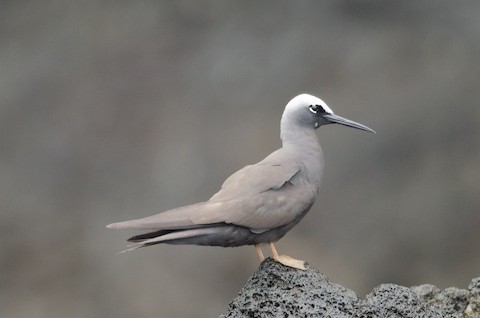
“Pacific Black Noddy,” A. m. minutus—or, based on its orangish feet and pale plumage, it could conceivably be a “Hawaiian Noddy” far out of its normal range. (Lord Howe Island, Australia; March 16, 2012.) © Nige Hartley

“Pacific Black Noddy,” A. m. minutus, at nest with nestling. (Lady Elliot Island, Queensland, Australia; December 12, 2020.) © Richard Fuller

“Pacific Black Noddy,” A. m. marcusi. (French Frigate Shoals, Hawaii; September 24, 2006.) © Cory Gregory

“Pacific Black Noddy,” A. m. minutus, with brownish legs. (Heron Island, Queensland, Australia; December 14, 2020.) © Frank Coman
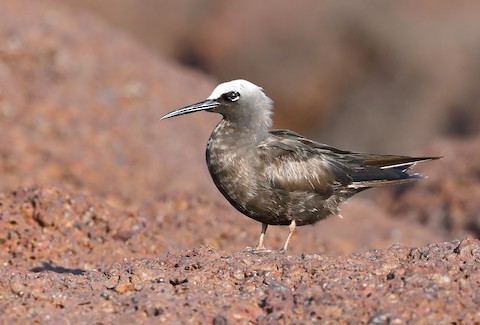
“Pacific Black Noddy,” A. m. minutus, in worn plumage, and with unusually pale legs. (Darwin, Northern Territory, Australia; August 17, 2020.) © Marc Gardner
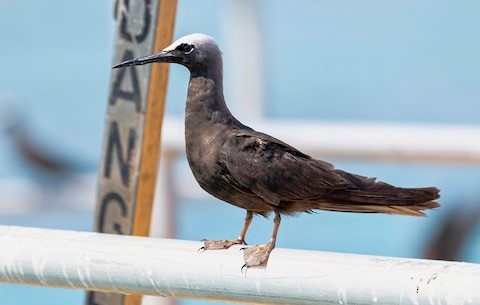
“Pacific Black Noddy,” A. m. minutus, with unusually pale, reddish legs. (Green Island National Park, Queensland, Australia; November 16, 2019.) © Jill Duncan & Ken Bissett

“Pacific Black Noddy,” A. m. marcusi. (Cocos Island, Guam; March 19, 2017.) © Matthew Bowman

“Pacific Black Noddy,” A. m. minutus, showing crown coloration more typical of Brown Noddy—but identification confirmed by bill shape. (Lady Elliot Island, Queensland, Australia; March 14, 2020.) © Barry Deacon
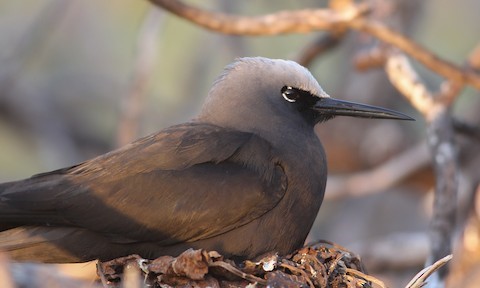
“Pacific Black Noddy,” A. m. marcusi, showing crown coloration more typical of Brown Noddy—but identification confirmed by bill shape. (Laysan Island, Hawaii; November 25, 2011.) © Cameron Rutt

“Pacific Black Noddy,” A. m. minutus. (Lady Elliot Island, Queensland, Australia; November 5, 2019.) © Matt Wright / Faunagraphic Wildlife Tours

“Pacific Black Noddy,” A. m. minutus. (Motu Tapu, Kiribati; August 18, 2019.) © Eric VanderWerf
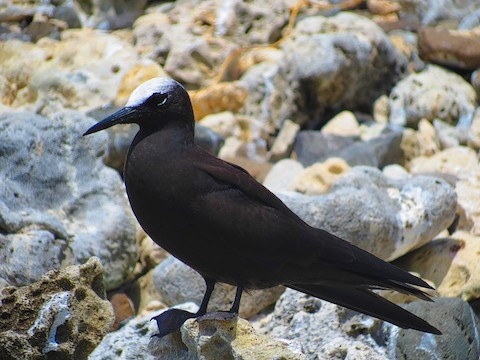
“Pacific Black Noddy,” A. m. minutus. (Lord Howe Island, Australia; February 7, 2013.) © Donna Nagiello
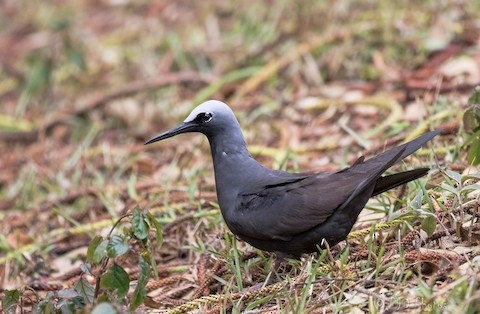
“Pacific Black Noddy,” A. m. minutus. (Hundred Acres Reserve, Norfolk Island; February 10, 2019.) © Jill Duncan & Ken Bissett

“Pacific Black Noddy,” A. m. minutus. (Relais Marama, Rotoava, French Polynesia; November 16, 2019.) © Ron Batie

“Pacific Black Noddy,” A. m. minutus. (Heron Island, Queensland, Australia; December 9, 2020.) © Frank Coman
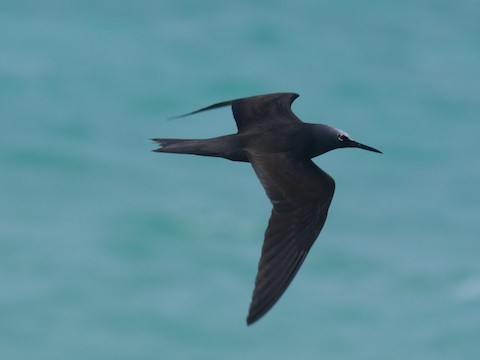
“Pacific Black Noddy,” A. m. minutus. (Heron Island, Queensland, Australia; December 9, 2020.) © Frank Coman
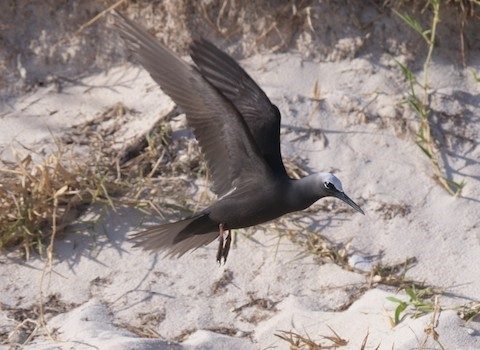
“Pacific Black Noddy,” A. m. minutus. (Heron Island, Queensland, Australia; December 11, 2020.) © Frank Coman

“Pacific Black Noddy,” A. m. minutus. (Bora Bora, French Polynesia; November 17, 2013.) © Geoff Dennis
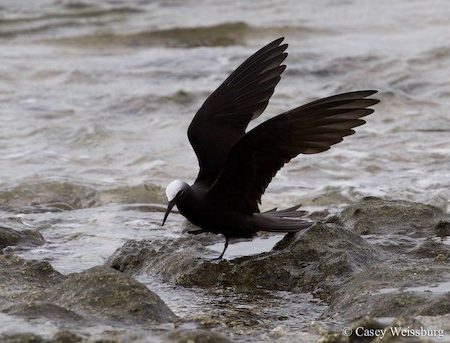
“Pacific Black Noddy,” A. m. minutus. (Ta’u, American Samoa; February 10, 2017.) © Casey Weissburg
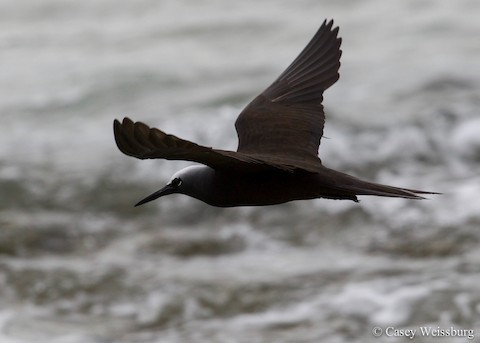
“Pacific Black Noddy,” A. m. minutus. (Ta’u, American Samoa; February 10, 2017.) © Casey Weissburg

“Pacific Black Noddy,” A. m. minutus. (Nukuloa, Wallis and Futuna; August 16, 2015.) © Thierry Nogaro

“Pacific Black Noddy,” A. m. minutus. (Bora Bora, French Polynesia; November 17, 2013.) © Geoff Dennis
Immatures resemble adults, but typically with a shorter bill and a white crown area that is usually smaller and uneven.
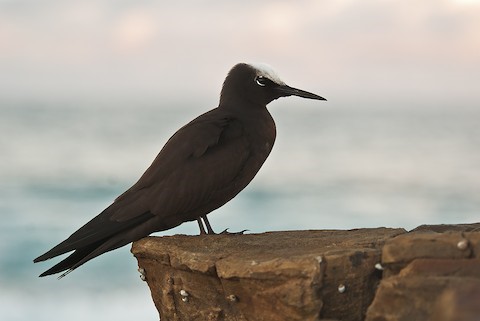
“Pacific Black Noddy,” A. m. minutus, immature. (Long Reef Aquatic Reserve, Collaroy, New South Wales, Australia; April 17, 2010.) © Dena Paris

“Pacific Black Noddy,” A. m. minutus, immature. (Flat Rock, Ballina, New South Wales, Australia; March 6, 2016.) © Andrew Naumann
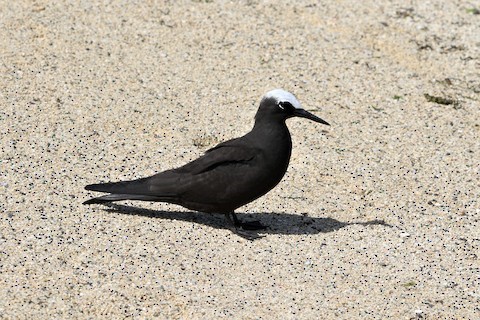
“Pacific Black Noddy,” A. m. minutus, apparently an immature. (Lord Howe Island, Australia; January 30, 2020.) © Peter Johnson
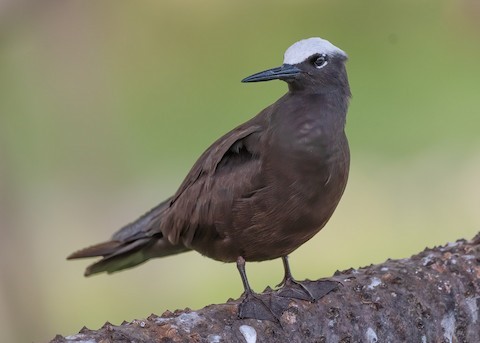
“Pacific Black Noddy,” A. m. minutus, immature. (Lady Elliot Island, Queensland, Australia; March 14, 2020.) © Barry Deacon

“Pacific Black Noddy,” A. m. minutus. (Flat Rock, Ballina, New South Wales, Australia; December 19, 2020.) © Hans Wohlmuth

“Pacific Black Noddy,” A. m. minutus, immature. (Heron Island, Queensland, Australia; February 24, 2018.) © Zhang Shen
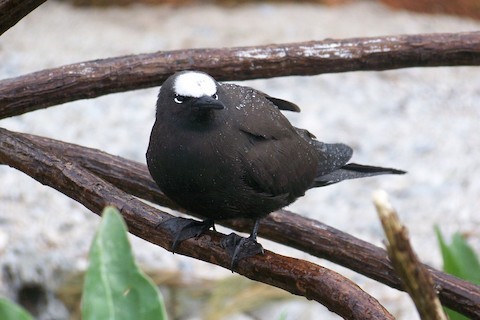
“Pacific Black Noddy,” A. m. minutus, apparently an immature. (Lady Elliot Island, Queensland, Australia; June 2, 2008.) © Sara Miller

“Pacific Black Noddy,” A. m. minutus, apparently an immature. (Lady Elliot Island, Queensland, Australia; June 2, 2008.) © Sara Miller
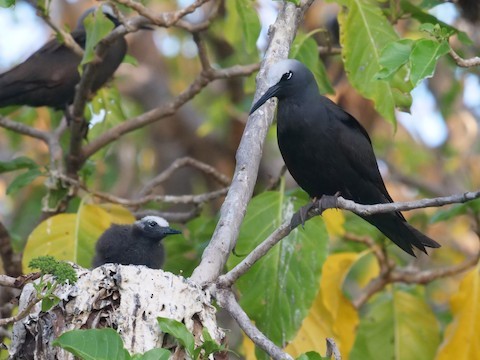
“Pacific Black Noddy,” A. m. minutus, adult with nestling. (Heron Island, Queensland, Australia; December 2, 2020.) © Frank Coman
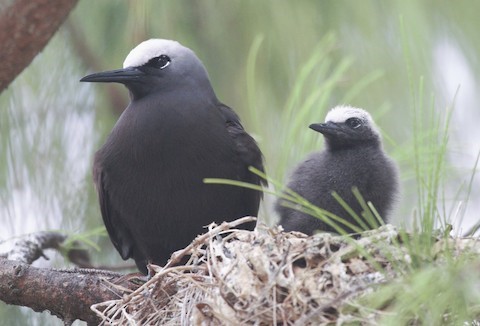
“Pacific Black Noddy,” A. m. marcusi, adult with nestling. (Sand Island, Midway Atoll National Wildlife Refuge, Hawaii; June 29, 2019.) © Jonathan Plissner

“Pacific Black Noddy,” A. m. marcusi, immature. (Offshore from French Frigate Shoals, Hawaii; April 3, 2020.) © Eric VanderWerf
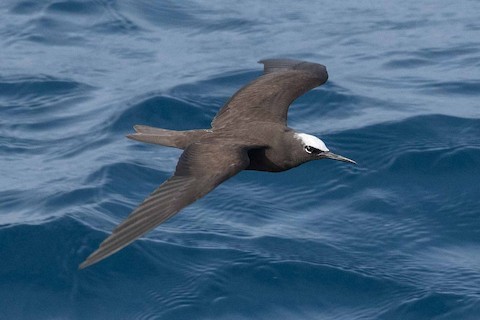
“Pacific Black Noddy,” A. m. marcusi, immature. (Offshore from French Frigate Shoals, Hawaii; April 3, 2020.) © Eric VanderWerf

“Pacific Black Noddy,” A. m. minutus, immature. (Flat Rock, Ballina, New South Wales, Australia; December 19, 2020.) © Hans Wohlmuth

“Pacific Black Noddy,” A. m. minutus, immature. (Flat Rock, Ballina, New South Wales, Australia; December 19, 2020.) © Hans Wohlmuth
Cf. Brown Noddy. Brown Noddy is so widespread that it occurs essentially throughout the ranges of all other noddies. Most noddy identification consists of distinguishing Brown from the relevant member(s) of the Black Noddy complex.
In most cases, “Atlantic” and “Pacific Black Noddies” are uniformly blackish and have a smaller, more crisply demarcated white crown area than Brown Noddy. However, in worn plumage and harsh lighting Black Noddies can appear brown and their crowns can appear more diffuse. Brown Noddy’s crown coloration also varies somewhat with factors that include molt-stage and lighting. When general coloration and crown demarcation are inconclusive, there are potentially more objective differences in overall structure, bill size and shape, and wing contrast.
Structure: Black is somewhat smaller and more buoyant (tern-like) in flight. Conversely, Brown is bulkier and more gull-like. Although the proportions between their wing and tail measurements are similar, Brown’s average about 15% longer and, when seen in flight, its tail feathers often create the impression of being disproportionately long.
Bill Size and Shape: Black’s bill is appreciably thinner and straighter—or, in other words, Brown’s bill is thicker and more noticeably curved. Black’s bill averages longer while the rest of its head is smaller than Brown’s. In most postures, Black’s eye appears “off-centered”—closer to the back of its head than to the tip of its bill—whereas Brown’s eye is about equidistant from the back of its head and the tip of its bill.

“Atlantic Black Noddy,” A. m. atlanticus (foreground) with Brown Noddy, showing differences in size, general coloration, and demarcation of white crown—note that the Brown Noddy appears much larger in the frame even though it is farther from the camera. (São Pedro e São Paulo, Brazil; November 24, 2018.) © Ronald Santiago
Wing Contrast: Black’s wings are usually darker than Brown’s, and nearly uniform on the upperside, with little contrast between the coverts and flight feathers—whereas Brown’s wings typically appear two-toned: brown on the coverts versus darker, more blackish on the adjacent flight feathers.
Cf. Lesser Noddy. The Lesser Noddy was traditionally considered a subspecies of Black Noddy, but it is widely recognized as a separate species. Lesser has distinctive features that differentiate it from the “Pacific Black Noddies” that occur with it in the eastern Indian Ocean, and from the “Atlantic Black Noddy”, which could readily stray to South Africa. Lesser typically has a longer bill and more extensive gray on the head and neck. In particular, Lesser has pale lores—noticeable at a distance as Lesser’s eye appears as an isolated dark patch on a mostly pale face.

Lesser Noddy, showing pale-gray lores. (West Island, Ashmore Reef, Western Australia; April 29, 2019.) © Magen Pettit

“Pacific Black Noddy,” A. m. minutus, showing black lores. (West Island, Ashmore Reef, Western Australia; April 29, 2019.) © Magen Pettit
Cf. “Hawaiian Noddy”. The “Hawaiian Noddy” is generally considered a subspecies of Black Noddy, but it seems likely to be recognized as a separate species eventually. Adult “Hawaiian” has distinctive features that differentiate it from the “Pacific Black Noddies” that sometimes occur with it—certainly around Ni’ihau, and possibly elsewhere in the main Hawaiian Islands. However, immature “Hawaiian” typically lacks the distinctive features of adults and in some cases may not be reliably differentiated from “Pacific Black”, so even well-documented photographic records of the latter in the main Hawaiian Islands are difficult to evaluate.
Tail Color: Most distinctively, “Hawaiian” has a gray (often pale gray) rump and tail that contrast with the darker back and belly. In almost all cases, “Pacific Black” has a blackish rump and tail that are concolor with the back and belly. In some instances, “Pacific Black” may show a slightly paler rump and tail, but this is atypical and would rarely approach the contrast in “Hawaiian’s” coloration.
Head Color: “Hawaiian” usually has a gray hood that is palest on the crown and gradually blends to darker shades, whereas “Pacific Black” has a white crown that contrasts boldly with its otherwise much darker plumage. This distinction is somewhat less reliable than the tail, however, because young “Hawaiians” have a more contrasty crown—roughly the same as typical “Pacific Blacks.” In addition, some “Pacific Blacks” seem to show less contrast than most and could be mistaken for “Hawaiians.”
Foot Color: “Hawaiian” typically has orange feet; “Pacific Black” typically has black feet; but there are many exceptions. Young “Hawaiians” have black or dark-brown feet and some adults may have very dull-looking feet. More confusingly, however, some “Pacific Blacks” (at least in some South Pacific populations far away from Hawaii) have variably paler, often orange feet.

An apparent “Pacific Black Noddy,” A. m. marcusi (or possibly a subadult “Hawaiian”) in a “Hawaiian Noddy” breeding colony—note the dark feet and strongly contrasting white crown compared to the orange feet and pale-gray hood of the adult “Hawaiian” below it. (Wai’anapanapa State Park, Maui, Hawaii; May 24, 2017.) © Nancy Christensen
Immatures: Immature “Hawaiian” is essentially all-dark and is easily mistaken for “Pacific Black.” Converse to the adult comparison, juvenile “Hawaiian” is more uniformly blackish than juvenile “Pacific Black” because “Hawaiian” typically begins with a dark crown whereas “Pacific Black” typically begins with a white crown. As they mature, “Hawaiians” become paler on the crown, elsewhere on the head and neck, and on the rump and tail—at one or more stages of this progression, they may be difficult or impossible to differentiate from “Pacific Black.”
Notes
Polytypic form consisting of four recognized subspecies, collectively one of three distinct forms of Black Noddy (A. minutus), along with “Atlantic Black” (americanus), and “Hawaiian” (melanogenys), all potentially classifiable as separate species.
A fourth form, the Lesser Noddy (A. tenuirostris), was traditionally regarded as conspecific (with all four forms together known collectively as either Black, White-capped, or Lesser Noddy, A. tenuirostris) but is generally acknowledged to be a separate species—as it is visually distinctive and apparently breeds alongside “Pacific Black Noddy” at Ashmore Reef without interbreeding.
Howell and Zufelt (2019) recognize each of the four forms as separate species. In addition to Lesser, it seems appropriate to classify “Hawaiian” as separate based on factors that include pronounced differences in plumage, leg color, and bill length, and their persistence as recognizably distinct despite overlapping ranges.
Assuming that both Lesser and “Hawaiian” are ultimately recognized as separate species, biogeographic logic would tend to imply that the other two forms, “Atlantic Black” and “Pacific Black”, should be presumptively separate as well—although they are very similar and might not be reliably distinguishable.
References
BirdLife International. 2020. Anous minutus. The IUCN Red List of Threatened Species 2020: e.T22694799A163885644. https://dx.doi.org/10.2305/IUCN.UK.2020-3.RLTS.T22694799A163885644.en. (Accessed December 24, 2020.)
Brazil, M. 2009. Birds of East Asia. Princeton University Press.
eBird. 2020. eBird: An online database of bird distribution and abundance. Cornell Lab of Ornithology, Ithaca, N.Y. http://www.ebird.org. (Accessed December 24, 2020.)
Harrison, P. 1983. Seabirds: An Identification Guide. Houghton Mifflin, Boston.
Howell, S.N.G., and S.W. Webb. 1995. A Guide to the Birds of Mexico and Northern Central America. Oxford University Press, Oxford.
Howell, S.N.G., and K. Zufelt. 2019. Oceanic Birds of the World. Princeton University Press.
Pratt, H.D., P.L. Bruner, and D.G. Berrett. 1987. A Field Guide to the Birds of Hawaii and the Tropical Pacific. Princeton University Press.
Pratt, H.D. 1993. Enjoying Birds in Hawaii: A Birdfinding Guide to the Fiftieth State (Second Edition). Mutual Publishing, Honolulu, Hawaii.
Pyle, R.L., and P. Pyle. 2017. The Birds of the Hawaiian Islands: Occurrence, History, Distribution, and Status. Version 2 (January 1, 2017). http://hbs.bishopmuseum.org/birds/rlp-monograph/. B.P. Bishop Museum, Honolulu, Hawaii.
Raine, H., and A.F. Raine. 2020. ABA Field Guide to the Birds of Hawai’i. Scott & Nix, Inc., New York.
Stiles, F.G., A.F. Skutch, and D. Gardner. 1989. A Guide to the Birds of Costa Rica. Cornell University Press.
Xeno-Canto. 2020. Black Noddy – Anous minutus. https://www.xeno-canto.org/species/Anous-minutus. (Accessed December 24, 2020.)

